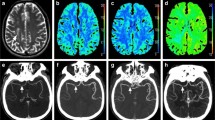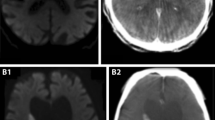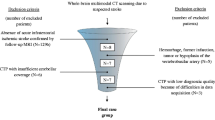Abstract
Introduction
C-arm flat detector computed tomography (FDCT) parenchymal blood volume (PBV) measurements allow assessment of cerebral haemodynamics in the neurointerventional suite. This paper explores the feasibility of C-arm computed tomography (CT) PBV imaging and the relationship between the C-arm CT PBV and the MR-PWI-derived cerebral blood volume (CBV) and cerebral blood flow (CBF) parameters in aneurysmal subarachnoid haemorrhage (SAH) patients developing delayed cerebral ischemia (DCI).
Methods
Twenty-six patients with DCI following aneurysmal SAH underwent a research C-arm CT PBV scan using a biplane angiography system and contemporaneous MR-PWI scan as part of a prospective study. Quantitative whole-brain atlas-based volume-of-interest analysis in conjunction with Pearson correlation and Bland-Altman tests was performed to explore the agreement between C-arm CT PBV and MR-derived CBV and CBF measurements.
Results
All patients received medical management, while eight patients (31 %) underwent selective intra-arterial chemical angioplasty. Colour-coded C-arm CT PBV maps were 91 % sensitive and 100 % specific in detecting the perfusion abnormalities. C-arm CT rPBV demonstrated good agreement and strong correlation with both MR-rCBV and MR-rCBF measurements; the agreement and correlation were stronger for MR-rCBF relative to MR-rCBV and improved for C-arm CT PBV versus the geometric mean of MR-rCBV and MR-rCBF. Analysis of weighted means showed that the C-arm CT PBV has a preferential blood flow weighting (≈60 % blood flow and ≈40 % blood volume weighting).
Conclusions
C-arm CT PBV imaging is feasible in DCI following aneurysmal SAH. PBV is a composite perfusion parameter incorporating both blood flow and blood volume weightings. That PBV has preferential (≈60 %) blood flow weighting is an important finding, which is of clinical significance when interpreting the C-arm CT PBV maps, particularly in the setting of acute brain ischemia.







Similar content being viewed by others
References
Zellerhoff M, Deuerling-Zheng Y, Strother CM, et al (2009) Measurement of cerebral blood volume using angiographic C-arm systems. p 72620H–72620H–8
Ahmed AS, Zellerhoff M, Strother CM et al (2009) C-Arm CT measurement of cerebral blood volume: an experimental study in canines. Am J Neuroradiol 30:917–922. doi:10.3174/ajnr.A1513
Bley T, Strother CM, Pulfer K et al (2010) C-Arm CT measurement of cerebral blood volume in ischemic stroke: an experimental study in canines. Am J Neuroradiol 31:536–540. doi:10.3174/ajnr.A1851
Struffert T, Deuerling-Zheng Y, Engelhorn T et al (2012) Feasibility of cerebral blood volume mapping by flat panel detector CT in the angiography suite: first experience in patients with acute middle cerebral artery occlusions. Am J Neuroradiol 33:618–625. doi:10.3174/ajnr.A2839
Struffert T, Deuerling-Zheng Y, Kloska S et al (2011) Cerebral blood volume imaging by flat detector computed tomography in comparison to conventional multislice perfusion CT. Eur Radiol 21:882–889. doi:10.1007/s00330-010-1957-6
Hamberg LM, Hunter GJ, Kierstead D et al (1996) Measurement of cerebral blood volume with subtraction three-dimensional functional CT. Am J Neuroradiol 17:1861–1869
Wittkamp G, Buerke B, Dziewas R et al (2010) Whole brain perfused blood volume CT: visualization of infarcted tissue compared to quantitative perfusion CT. Acad Radiol 17:427–432. doi:10.1016/j.acra.2009.11.005
Lu J, Zhang M, Cao Y et al (2011) Three-dimensional whole-brain perfused blood volume imaging with multimodal CT for evaluation of acute ischaemic stroke. Clin Radiol 66:517–525. doi:10.1016/j.crad.2011.01.003
Kloska SP, Fischer T, Nabavi DG et al (2007) Color-coded perfused blood volume imaging using multidetector CT: initial results of whole-brain perfusion analysis in acute cerebral ischemia. Eur Radiol 17:2352–2358. doi:10.1007/s00330-007-0580-7
Sharma M, Fox AJ, Symons S et al (2011) CT angiographic source images: flow- or volume-weighted? Am J Neuroradiol 32:359–364. doi:10.3174/ajnr.A2282
Diringer MN, Bleck TP, Claude Hemphill J 3rd et al (2011) Critical care management of patients following aneurysmal subarachnoid hemorrhage: recommendations from the Neurocritical Care Society’s Multidisciplinary Consensus Conference. Neurocrit Care 15:211–240. doi:10.1007/s12028-011-9605-9
Dankbaar JW, Rijsdijk M, van der Schaaf IC et al (2009) Relationship between vasospasm, cerebral perfusion, and delayed cerebral ischemia after aneurysmal subarachnoid hemorrhage. Neuroradiology 51:813–819. doi:10.1007/s00234-009-0575-y
Dankbaar JW, de Rooij NK, Rijsdijk M et al (2010) Diagnostic threshold values of cerebral perfusion measured with computed tomography for delayed cerebral ischemia after aneurysmal subarachnoid hemorrhage. Stroke 41:1927–1932. doi:10.1161/STROKEAHA.109.574392
Sanelli PC, Ugorec I, Johnson CE et al (2011) Using quantitative CT perfusion for evaluation of delayed cerebral ischemia following aneurysmal subarachnoid hemorrhage. Am J Neuroradiol 32:2047–2053. doi:10.3174/ajnr.A2693
Fisher CM, Kistler JP, Davis JM (1980) Relation of cerebral vasospasm to subarachnoid hemorrhage visualized by computerized tomographic scanning. Neurosurgery 6:1–9
Jenkinson M, Beckmann CF, Behrens TEJ et al (2012) FSL. NeuroImage 62:782–790. doi:10.1016/j.neuroimage.2011.09.015
Smith SM (2002) Fast robust automated brain extraction. Hum Brain Mapp 17:143–155. doi:10.1002/hbm.10062
Jenkinson M, Bannister P, Brady M, Smith S (2002) Improved optimization for the robust and accurate linear registration and motion correction of brain images. NeuroImage 17:825–841
Martin Bland J, Altman D (1986) Statistical methods for assessing agreement between two methods of clinical measurement. Lancet 327:307–310. doi:10.1016/S0140-6736(86)90837-8
Rijsdijk M, van der Schaaf IC, Velthuis BK et al (2008) Global and focal cerebral perfusion after aneurysmal subarachnoid hemorrhage in relation with delayed cerebral ischemia. Neuroradiology 50:813–820. doi:10.1007/s00234-008-0416-4
Struffert T, Deuerling-Zheng Y, Kloska S et al (2010) Flat detector CT in the evaluation of brain parenchyma, intracranial vasculature, and cerebral blood volume: a pilot study in patients with acute symptoms of cerebral ischemia. Am J Neuroradiol 31:1462–1469. doi:10.3174/ajnr.A2083
Konstas AA, Goldmakher GV, Lee T-Y, Lev MH (2009) Theoretic basis and technical implementations of CT perfusion in acute ischemic stroke, part 1: theoretic basis. Am J Neuroradiol 30:662–668. doi:10.3174/ajnr.A1487
Kamran M, Nagaraja S, Byrne JV (2010) C-arm flat detector computed tomography: the technique and its applications in interventional neuro-radiology. Neuroradiology 52:319–327. doi:10.1007/s00234-009-0609-5
Mordasini P, El-Koussy M, Brekenfeld C et al (2012) Applicability of tableside flat panel detector CT parenchymal cerebral blood volume measurement in neurovascular interventions: preliminary clinical experience. Am J Neuroradiol 33:154–158. doi:10.3174/ajnr.A2715
Mir DIA, Gupta A, Dunning A et al (2013) CT perfusion for detection of delayed cerebral ischemia in aneurysmal subarachnoid hemorrhage: a systematic review and meta-analysis. Am J Neuroradiol. doi:10.3174/ajnr.A3787
Mills JN, Mehta V, Russin J et al (2013) Advanced imaging modalities in the detection of cerebral vasospasm. Neurol Res Int 2013, e415960. doi:10.1155/2013/415960
Essig M, Shiroishi MS, Nguyen TB et al (2013) Perfusion MRI: the five most frequently asked technical questions. AJR Am J Roentgenol 200:24–34. doi:10.2214/AJR.12.9543
Fieselmann A, Ganguly A, Deuerling-Zheng Y et al (2012) Interventional 4-D C-Arm CT perfusion imaging using interleaved scanning and partial reconstruction interpolation. IEEE Trans Med Imaging 31:892–906. doi:10.1109/TMI.2011.2181531
Royalty K, Manhart M, Pulfer K et al (2013) C-Arm CT measurement of cerebral blood volume and cerebral blood flow using a novel high-speed acquisition and a single intravenous contrast injection. Am J Neuroradiol 34:2131–2138. doi:10.3174/ajnr.A3536
Acknowledgments
The authors would like to thank the staff and Department of Neuroradiology, John Radcliffe Hospital, Oxford, UK, for their support in patient recruitment and scanning. We also thank Siemens for the hardware and software support. MK would like to thank The Rhodes Trust, Oxford, for funding his doctoral studies at the University of Oxford.
Ethical Standards and Patient Consent
We declare that all human and animal studies have been approved by the Coventry Research Ethics Committee and have therefore been performed in accordance with the ethical standards laid down in the 1964 Declaration of Helsinki and its later amendments. We declare that all patients gave informed consent prior to inclusion in this study.
Conflict of Interest
We declare that we have no conflict of interest.
Author information
Authors and Affiliations
Corresponding author
Rights and permissions
About this article
Cite this article
Kamran, M., Byrne, J.V. C-arm flat detector computed tomography parenchymal blood volume imaging: the nature of parenchymal blood volume parameter and the feasibility of parenchymal blood volume imaging in aneurysmal subarachnoid haemorrhage patients. Neuroradiology 57, 937–949 (2015). https://doi.org/10.1007/s00234-015-1545-1
Received:
Accepted:
Published:
Issue Date:
DOI: https://doi.org/10.1007/s00234-015-1545-1




